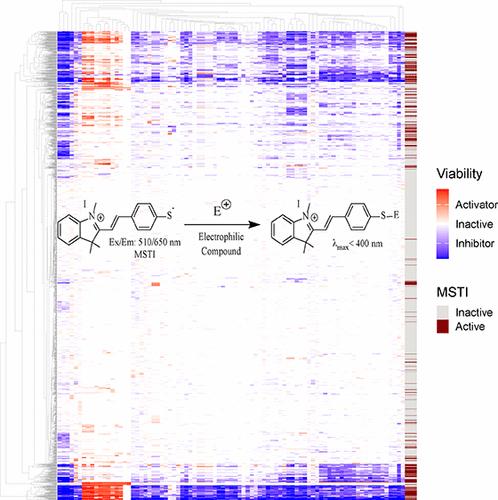评估 MSTI 分析法在预测化合物杂合性和细胞毒性方面的实用性
IF 3.7
3区 医学
Q2 CHEMISTRY, MEDICINAL
引用次数: 0
摘要
非特异性反应化学物质由于其杂交性和/或细胞毒性,往往会干扰高通量检测结果的解读。要有效排除潜在的检测假象,就必须使用高通量检测方法来鉴定此类化合物。MSTI((E)-2-(4-巯基丙烯酰基)-1,3,3-三甲基-3H-吲哚-1-鎓)检测法使用含巯基的荧光探针来筛选亲电子反应性,可用于确定非特异性反应性化合物。此前,Tox21 10K 化合物库已通过包括生化 MSTI 检测在内的 80 种细胞和生化检测方法进行了筛选。在本研究中,我们比较了 Tox21 10K 化合物的 MSTI 检测活性和它们在 Tox21 检测面板中的活性所反映的杂交性和细胞毒性,以确定:(1) 该检测是否能预测化合物的杂交性和细胞毒性;(2) 哪些化学特征会导致 MSTI 检测活性和杂交性/细胞毒性之间出现不一致的结果(假阴性和假阳性)。我们发现,MSTI 检测法能以 0.55 的灵敏度和 0.97 的特异性预测化学品的杂交性/细胞毒性。在评估的 3,407 种独特化合物中,我们发现了 92 个假阳性结果和 227 个假阴性结果。在假阳性和假阴性结果中,分别有 53% (p = 2.4 × 10-07) 和 19% (p = 4.3 × 10-06) 的化合物具有羧酰胺和烷基卤化物等结构特征。这项分析的结果将有助于确定这种高通量测定的潜在挑战,并使研究人员能够以有效的方式确定化合物是具有细胞毒性还是具有杂合性。本文章由计算机程序翻译,如有差异,请以英文原文为准。

Evaluating the Utility of the MSTI Assay in Predicting Compound Promiscuity and Cytotoxicity
Nonspecific reactive chemicals often interfere with the interpretation of high-throughput assay results because of their promiscuity and/or cytotoxicity. Using a high-throughput assay to identify such compounds is necessary to efficiently rule out potential assay artifacts. The MSTI, (E)-2-(4-mercaptostyryl)-1,3,3-trimethyl-3H-indol-1-ium, assay uses a thiol-containing fluorescent probe to screen for electrophile reactivity and could potentially be used to determine nonspecific reactive compounds. The Tox21 10K compound library was previously screened against a panel of ∼80 cell-based and biochemical assays, including the biochemical MSTI assay. In this study, we compared the MSTI assay activity of the Tox21 10K compounds with their promiscuity and cytotoxicity as reflected by their activities across the Tox21 assay panel to determine: (1) if this assay is predictive of a compound’s promiscuity and cytotoxicity and (2) what chemical features create inconsistent results between the MSTI assay activity and promiscuity/cytotoxicity (false negatives and false positives). We found that the MSTI assay can predict a chemical’s promiscuity/cytotoxicity with a 0.55 sensitivity and 0.97 specificity. Out of 3,407 unique compounds evaluated, we identified 92 false positive and 227 false negative results. Several structural features such as carboxamides and alkyl halides were found to be apparent in 53% (p = 2.4 × 10–07) and 19% (p = 4.3 × 10–06) of the false positives and negatives, respectively. The results of this analysis will help identify the potential challenges of this high-throughput assay and allow researchers to identify if a compound will be cytotoxic or promiscuous in an efficient manner.
求助全文
通过发布文献求助,成功后即可免费获取论文全文。
去求助
来源期刊
CiteScore
7.90
自引率
7.30%
发文量
215
审稿时长
3.5 months
期刊介绍:
Chemical Research in Toxicology publishes Articles, Rapid Reports, Chemical Profiles, Reviews, Perspectives, Letters to the Editor, and ToxWatch on a wide range of topics in Toxicology that inform a chemical and molecular understanding and capacity to predict biological outcomes on the basis of structures and processes. The overarching goal of activities reported in the Journal are to provide knowledge and innovative approaches needed to promote intelligent solutions for human safety and ecosystem preservation. The journal emphasizes insight concerning mechanisms of toxicity over phenomenological observations. It upholds rigorous chemical, physical and mathematical standards for characterization and application of modern techniques.

 求助内容:
求助内容: 应助结果提醒方式:
应助结果提醒方式:


